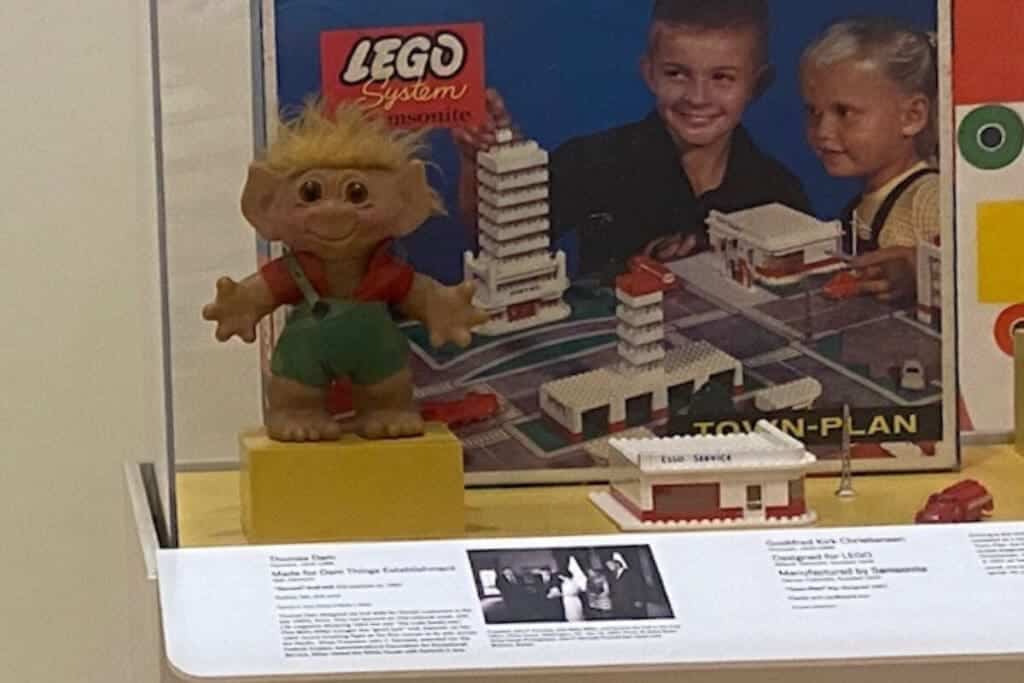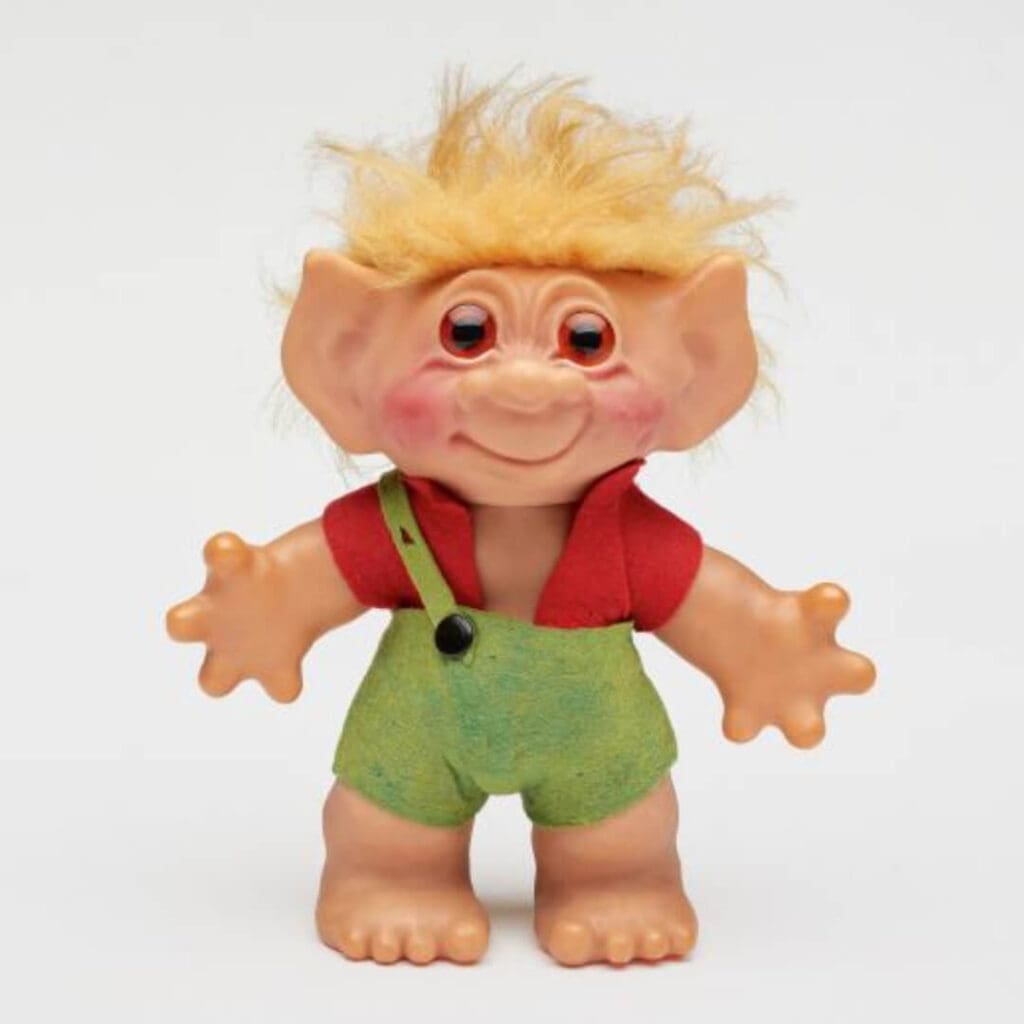The troll doll was one of the classic Scandinavian designs shown at the recent Scandinavian Design and the United States show from 1890 to 1980 at the Milwaukee Art Museum. As a child, I remember having several of these iconic troll dolls.
Thomas Dam was a baker who was struggling after World War II. He could no longer provide for his family, so he started to carve these iconic troll dolls. The dolls would eventually become so popular that they became a symbol worldwide of innovative and great Scandinavian design. Read on to go into the history of Thomas Dam and his company, Made for Dam Things, and their troll dolls.
Table of Contents
- The Origin Of Troll Dolls: Thomas Dam And The Made For Dam Things Establishment
- Thomas Dam And His Troll Dolls Are An Iconic Scandinavian Design
- Related Content
The Origin Of Troll Dolls: Thomas Dam And The Made For Dam Things Establishment
Troll dolls have become iconic figures in popular culture, capturing the imagination of generations. At the center of this phenomenon is Thomas Dam, the creator of troll dolls, and his establishment, Made For Dam Things.
Like many great designs, the iconic troll dolls have a fascinating history. Read on as we explore troll dolls’ origins, rise to fame, and cultural impact.


We will delve into Thomas Dam’s journey from a struggling baker in post-World War II Denmark to a renowned sculptor and toy maker.
The Early Beginnings Of Thomas Dam
Thomas Dam’s story begins with adversity. As a baker facing the economic challenges of World War II, Dam sought alternative ways to support his family. After World War II, there was not enough flour for him to be able to run his bakery,
It was in his moment of despair that he discovered his talent for carving wooden figurines while entertaining his children. Encouraged by his wife, he decided to sell these figurines, marking the start of his toy-making journey.
From Wooden Figurines To Troll Dolls
Dam initially succeeded when he sold his wooden figurines in Aalborg, Denmark. Customers began commissioning larger projects, establishing Dam as a respected sculptor.
Pivotal moments they occurred when Dam created a window display featuring bouncing Christmas elves, which sparked the idea for troll dolls. The dolls’ unique mechanism captured customers’ attention and ignited demand.
The Rise Of Troll Dolls
The increasing popularity of troll dolls led Dam to establish Made For Dam Things, his own company dedicated to their production. Initially handcrafted from wood with expensive springs, Dam transitioned to more affordable rubber molds.
He established a factory in Gjøl, Denmark, adopting rotational molding techniques to scale production. Troll dolls soon became an international sensation, with factories spanning the globe.
Troll Dolls And Their Cultural Impact
The pricing and marketing strategies of troll dolls, including accessories, made them not just toys but also collectibles. Their vibrant aesthetics reflected the spirit of the 1960s, captivating the cultural zeitgeist.
Furthermore, troll dolls tapped into a fascination with creatures of duality, embodying both cuteness and a hint of terror. They became symbols of luck and laughter, resonating with consumers and even catching the attention of prominent figures like President John F. Kennedy and First Lady Lady Bird Johnson.
Challenges And Decline Of Troll Dolls
Despite their immense popularity, Dam’s company faced challenges. Competitors in the United States took advantage of copyright law gaps, flooding the market with cheaper knockoffs. The changing toy trends and evolving consumer preferences also contributed to the decline of troll dolls.
His company, Made For Dam Things, encountered financial struggles, and the prominence of troll dolls dwindled in the toy industry.
Thomas Dam And His Troll Dolls Are An Iconic Scandinavian Design
Thomas Dam and the Made For Dam Things establishment played a vital role in the origin and rise of troll dolls. Dam’s creativity and entrepreneurial spirit turned his carved wooden figurines into a global sensation.

Troll dolls captured the hearts of millions, symbolizing luck, laughter, and a fascinating blend of cuteness and eerie charm. Although challenges and competition impacted their popularity, the enduring legacy of troll dolls remains.
They hold a significant place in popular culture, reminding us of imaginative power and ability to transcend generations. Thomas Dam’s contribution to Scandinavian designs and toy history is a testament to human ingenuity and the impact of a simple idea brought to life.
Troll dolls, born out of the creativity and perseverance of Thomas Dam, have left an indelible mark on popular culture. Their enduring legacy continues to captivate children and adults alike, reminding us of the joy and wonder toys can bring.
Thomas Dam’s Iconic Design Is A Testament Of Great Innovation
Thomas Dam’s journey from a struggling baker to a renowned toy maker is a testament to the power of innovation and the pursuit of one’s passion.

Despite the challenges faced by Dam and his company, their contributions to the toy industry cannot be overlooked. The origin and rise of troll dolls showcase the transformative power of a simple idea brought to life through craftsmanship and ingenuity.
Thomas Dam’s ability to adapt to changing demands, streamline production processes, and tap into cultural trends allowed troll dolls to become a global sensation.
Listen to our podcast about troll dolls: From Thomas Dam to Made-for-Dam Things – A global trade gal exploration below or by clicking here.

The Troll Dolls Are A Cultural Icon
The cultural impact of troll dolls is undeniable. With their vibrant hair and unique features, these whimsical creatures became symbols of luck and laughter. They tapped into a more profound fascination with mythology, embodying a duality of cuteness and a hint of darkness.
The allure of troll dolls transcended borders, attracting the attention of influential figures and captivating the hearts of millions.
The origin and rise of troll dolls owe much to the creative vision and entrepreneurial spirit of Thomas Dam. His journey from a struggling baker to the creator of a global sensation is a testament to the power of resilience and the ability to bring joy to the world through toys.
Despite the challenges faced and the changing tides of the toy industry, troll dolls remain a cherished part of popular culture. They serve as a testament to the enduring impact that simple toys can have on our lives and the timeless magic they bring.
Find out more about how Mondoro can help you create, develop, and manufacture excellent home decor and furniture products – don’t hesitate to contact me, Anita. Check out my email by clicking here or become a part of our community and join our newsletter by clicking here.
Mondoro gives out a FREE Lookbook to anyone interested. You can receive a copy of our latest Lookbook by clicking here.
Listen to our Podcast called Global Trade Gal. You can find it on all major podcast platforms. Try out listening to one of our podcasts by clicking here.
Subscribe to our Mondoro Company Limited YouTube Channel with great videos and information by clicking here.
Related Content
The Tre Natural Color Trend for Home Decor and Home Furniture
Tre means bamboo. But it also helps to symbolize the strength and ability to be resilient. The Tre trend concerns nature as part of your life and home. The Tre natural color palette has a lot of lush green tones. The Tre trend can be used with other home decor and furniture trends.
You can discover more by reading The Tre Natural Color Trend for Home Decor and Home Furniture by clicking here.
Can Cane Furniture Be Left Outside?
Cane furniture is not weather-resistant; manufacturers produce outdoor weather-resistant furniture from synthetic, not natural, cane materials. Throughout history, cane furniture was in outdoor settings in many parts of the world; during that time, there was no genuinely outdoor weather-resistant furniture.
You can learn more by reading Can Cane Furniture Be Left Outside? by clicking here.
What Is The Difference Between Rattan, Wicker, And Cane Furniture?
Rattan is a type of palm or vine that grows in the jungles of Southeast Asia. Rattan refers to a kind of natural material. Wicker is a type of weave using rattan materials. Cane also refers to a type of weave that is usually woven using rattan material.
You can learn more by reading our blog What Is The Difference Between Rattan, Wicker, And Cane Furniture? by clicking here.

